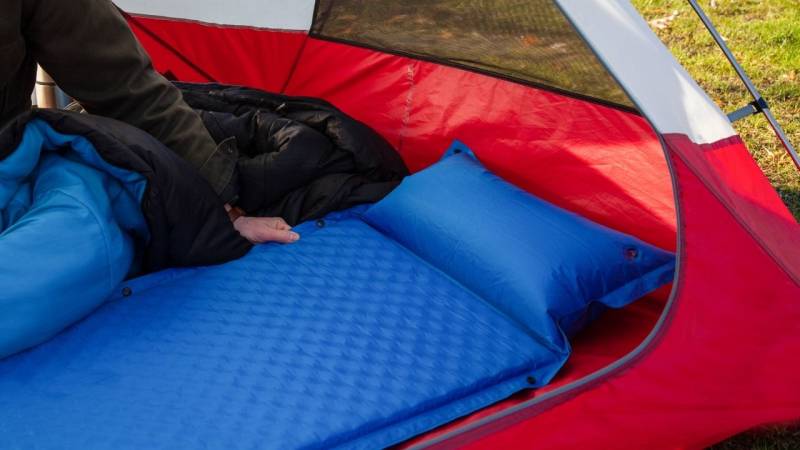
sleeping mat
Nomen
Meaning
A sleeping mat is an essential piece of equipment for outdoor enthusiasts, especially those involved in survival, bushcraft, camping, hiking, and wilderness activities. It provides insulation and cushioning between your body and the ground, ensuring a comfortable and restful sleep in any terrain or weather conditions. A good sleeping mat is lightweight, compact, and easy to carry, making it a must-have item for backpackers and adventurers. It helps to prevent heat loss, protects you from cold and dampness, and improves overall sleep quality. Investing in a high-quality sleeping mat is crucial for a successful and enjoyable outdoor experience.

Examples
„I love going on camping trips and sleeping under the stars, but a good sleeping mat is essential for a comfortable night's sleep.“
„When I go hiking, I always make sure to pack my lightweight sleeping mat. It provides insulation from the cold ground and keeps me comfortable throughout the night.“
„During a recent survival training course, we learned how to make a makeshift sleeping mat using natural materials like leaves and branches. It was surprisingly effective and kept us warm and dry.“
„My friend and I were discussing our camping gear, and he mentioned that he had just bought a new sleeping mat. He said it was incredibly comfortable and made a huge difference in his sleep quality.“
„After a long day of bushcraft activities, I was grateful for my trusty sleeping mat. It provided a soft and cushioned surface to rest on, allowing me to recharge for the next day's adventures.“
Origin
The word "sleeping mat" originates from the English language. It is a compound noun formed by combining the words "sleeping" and "mat".
The word "sleeping" refers to the act of resting or slumbering, while "mat" refers to a flat piece of material used for various purposes, such as cushioning or insulation.
The concept of using a mat for sleeping dates back to ancient times, where people would use natural materials like leaves, grass, or animal skins to create a comfortable surface to sleep on.
Over time, the design and materials used for sleeping mats have evolved. Today, sleeping mats are commonly made from lightweight and durable materials like foam, inflatable air chambers, or self-inflating pads.
Sleeping mats are an essential piece of gear for outdoor enthusiasts, campers, and survivalists. They provide insulation and cushioning, helping to improve comfort and sleep quality while camping or sleeping in the wilderness.
Synonyms
Camping mat, Mattress pad, Ground pad, Sleeping cushion, Outdoor mat, Camping mattress, Sleeping pad
Antonyms
Uncomfortable, Hard, Cold, Uneven, Thin, Deflated, Bulky, Heavy
Relatives
Sleeping pad, Camping mat, Air mattress, Sleeping bag, Camping gear, Outdoor equipment, Backpacking gear, Camping essentials
Historical and cultural importance
A sleeping mat is an essential piece of equipment for any outdoor enthusiast or adventurer. It provides insulation and comfort while sleeping in the wilderness, ensuring a good night's rest. But did you know that the use of sleeping mats dates back centuries and has cultural significance in various parts of the world?
In ancient times, different cultures developed their own versions of sleeping mats to suit their specific needs and environments. For example, the Native Americans used woven mats made from natural materials like reeds or grasses. These mats were lightweight, portable, and provided insulation from the cold ground.
In Japan, the traditional sleeping mat is called a "tatami." Made from rice straw, these mats are known for their durability and ability to regulate temperature. Tatami mats are still widely used in Japanese homes and are considered a symbol of traditional Japanese culture.
In Africa, sleeping mats are often made from woven palm leaves or grasses. These mats are not only used for sleeping but also serve as multipurpose items, such as seating or floor coverings. They are an integral part of African culture and are often decorated with intricate patterns and designs.
Today, modern sleeping mats are made from a variety of materials, including foam, inflatable air chambers, and self-inflating designs. They have evolved to be lightweight, compact, and highly efficient in providing insulation and comfort.
Understanding the historical and cultural relevance of sleeping mats adds depth to our appreciation of this essential piece of outdoor gear. Whether you're camping, backpacking, or simply enjoying a night under the stars, a sleeping mat ensures a restful sleep and connects us to the rich traditions of outdoor living.
More information about the term sleeping mat
What is a Sleeping Mat?
A sleeping mat is an essential piece of equipment for any outdoor enthusiast or adventurer. It is a portable and lightweight pad that provides insulation and cushioning between your body and the ground when sleeping outdoors. Sleeping mats are designed to improve comfort, warmth, and support while camping, hiking, or engaging in any outdoor activity that requires spending the night in a tent or under the stars.
The Importance of a Sleeping Mat
When you're out in the wilderness, a good night's sleep is crucial for your physical and mental well-being. A sleeping mat plays a vital role in ensuring a comfortable and restful sleep by providing several benefits:
1. Insulation: A sleeping mat acts as a barrier between your body and the cold ground, preventing heat loss and keeping you warm throughout the night. It helps to retain your body heat and provides insulation against the cold, damp, or uneven terrain.
2. Comfort: Sleeping on the hard ground can be uncomfortable and lead to a restless night's sleep. A sleeping mat adds a layer of cushioning, relieving pressure points and providing a more comfortable sleeping surface. It helps to reduce discomfort and promotes better sleep quality.
3. Support: A sleeping mat offers support to your body, especially your back and joints. It helps to distribute your body weight evenly, reducing strain on your spine and ensuring proper alignment. This support is particularly important for those with back or joint issues.
Types of Sleeping Mats
There are various types of sleeping mats available, each with its own features and benefits. Some common types include:
1. Foam Sleeping Mats: These mats are made of closed-cell foam and are lightweight, durable, and affordable. They provide good insulation and cushioning but may be bulkier to pack compared to other options.
2. Inflatable Sleeping Mats: These mats are made of lightweight materials and can be inflated using your breath or a pump. They offer excellent insulation, cushioning, and comfort. Inflatable mats are compact when deflated, making them easy to carry in your backpack.
3. Self-Inflating Sleeping Mats: These mats combine the benefits of foam and inflatable mats. They have an inner foam core that expands and self-inflates when the valve is opened. Self-inflating mats provide a good balance of comfort, insulation, and packability.
Tips for Choosing a Sleeping Mat
When selecting a sleeping mat, consider the following factors:
1. Size and Weight: Choose a mat that is lightweight and compact, making it easy to carry during your outdoor adventures. Consider the size that suits your body and sleeping style.
2. Insulation: Look for a mat with good insulation properties, especially if you plan to camp in colder temperatures. Check the R-value, which indicates the mat's thermal resistance.
3. Comfort and Support: Test the mat's cushioning and support to ensure it meets your comfort needs. Consider the thickness, material, and construction of the mat.
4. Durability: Opt for a mat that is durable and can withstand rough terrain and frequent use. Look for materials that are puncture-resistant and easy to clean.
Remember, a good sleeping mat is an investment in your outdoor comfort and well-being. It can make a significant difference in the quality of your sleep and overall camping experience. So, choose wisely and enjoy a restful night under the stars!
Back to overview

